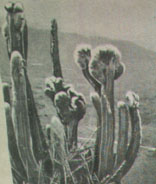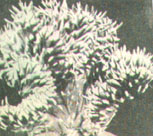CACTI FASCIATIONS
Irina A. Zaletaeva, Moscow; Magazine "Flower growing", 1971
 |
| Photo 1. Crested and normal forms of Espostoa sericata in the mountains of Peru (photo from the book by V.Haage "Freidemit kakteen", Berlin, 1957). |
Sometimes cacti have an unusual form, not round or cylindrical but whimsical and at the first site mysterious. Some of them look like an uneven rock, others have something like a bird's crest at the top of the stem.
These are the so-called fasciations that give forms of modified growing. They occur at different cacti, but some genera have them more often and others more rarely. One form is called monstrose (after the Latin "monstrus" - monster), the other is called crested (after the Latin "crista" - crest).
They appear when instead of one top areole (as a normal cactus has) the plant has several growing areoles. They can develop differently. If all the areoles around the plant grow they form several offsets - it is a monstrose form. Growing areoles of crested forms are placed in line crossing the top growing point.
 |
| Photo 2. Crested form of Opuntia cyilindrica (photo from the book by V.Haage "Freidemit kakteen", Berlin, 1957). |
Quite often beginners mix terms "form" and "variety". The fact is that the signs of a variety, like the signs of a species, accompany the plant from the beginning of its development up to its death, they are unchangeable. The form, both monstrose and crested, may suddenly appear at any cactus and change its stem forever or disappear suddenly again, after that the plant will grow normally. In this case a separate (or several separate) normal shoots appear from a fasciated cactus or all the upper part of the crest gathers to one normal stem. The normal growing may become constant or sometimes the crested form may reappear in a year or two (or possibly later) on one of the normal stems. This abnormality of growing remains quite mysterious as the reasons are not known and scientists explain it differently. Some cacti collectors in America mentioned that crested forms are more frequent near the seaside than far from it. It is also known that where one crested form was found you will certainly find others. Among the possible reasons of fasciations are rather unusual ones including injures left by woodpeckers and lightning strokes.
 |
| Photo 3. Crested form of Erithelantha micromeris that gave several normal shoots (photo by L.Zhaurov). |
Some scientists believed that crested forms are the reaction of cacti to injures made by larvae living in stems or reported that some bacteria or viruses were found in the crested forms of cacti. Others, like the famous expert on such plants Kurt Bakeberg, stated that fasciations are not connected with diseases and usually appear on old, strong, healthy plants.
Attempts to get fasciated forms failed. Work conducted by Voitus in 1938 is more or less typical of what has been done in this area. He exposed young Echinopsis to different physical and chemical influences: he made cuttings across the growing point, cut off the upper part of the stem, inserted rusted nails into the stem, made cuttings around all the stem, poured salt, soda and other stuffs solutions into wounds, injected lactic, oxalic, formic acids and other chemicals, also pure water into stems. He never got a single crested form. Changes in agrotechnics (planting cacti in different types of soil mixtures at different levels of humidity) gave no results either.
Moreover, scientists have different opinions even concerning the points where crests grow. Some state that a crest grows only from its sides, others say that only its center grows. In my opinion the whole surface of the crested form grows.
During dozens of years one believed that if monstrose forms can sometimes grow on own roots crested forms can survive only when grafted. A wedge-shaped graft on high upward Cereus was recommended. The spread-out crest should be cut out on sides lengthwise as such a crest grows smaller and gives an abundance of degenerated offsets dying off soon.
I can not agree that grafting of crested forms is obligatory guiding by my experience. I have crested forms of three different species growing on own roots successfully. It is interesting that one of them - Notocactus scopa f. cristata - started growing upward and giving 14 normal beautiful offsets after the crest had grown to its limit.
As books say crested and monstrose forms bloom rarely and set seeds still more rarely. Some scientists believe that studying seedlings got out of seeds gathered from fasciated cacti will help to solve the mystery of crested forms.
*Areole is a specific organ of cacti. It is a kind of modified and combined shoot and axillary bud of the plant. The lower part of areole has spines and the upper part is a potential growing point, it gives growth at treelike species or a bud when blooming.
If the normal top growing point is damaged one or several areoles on the stem of the cactus "undertake" its functions and give growth.





